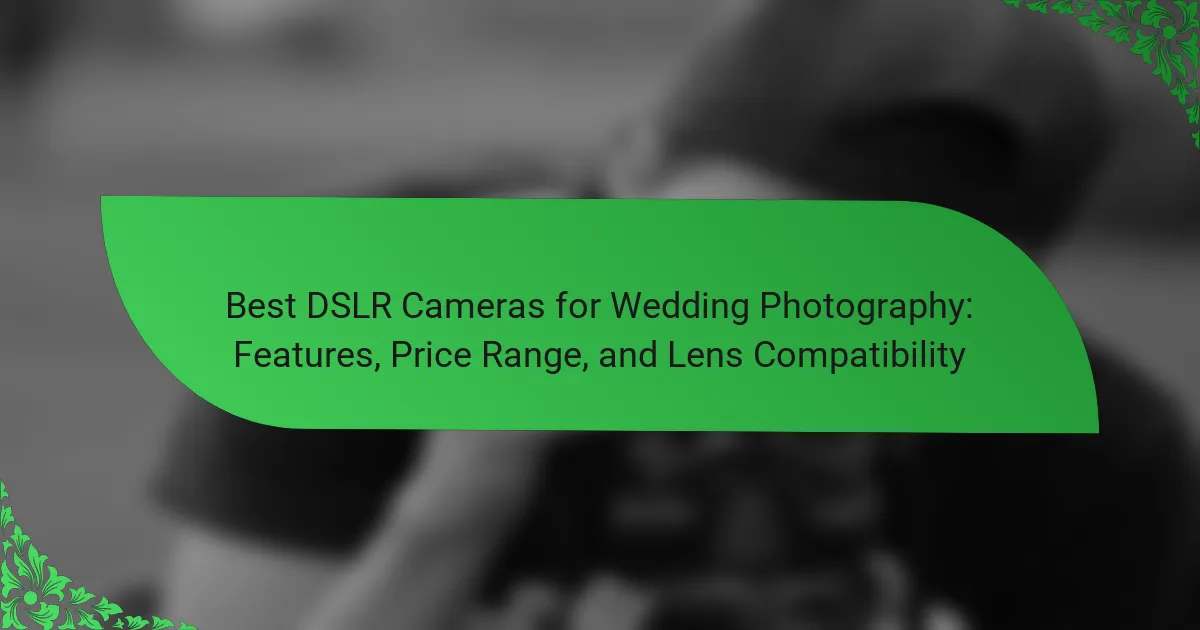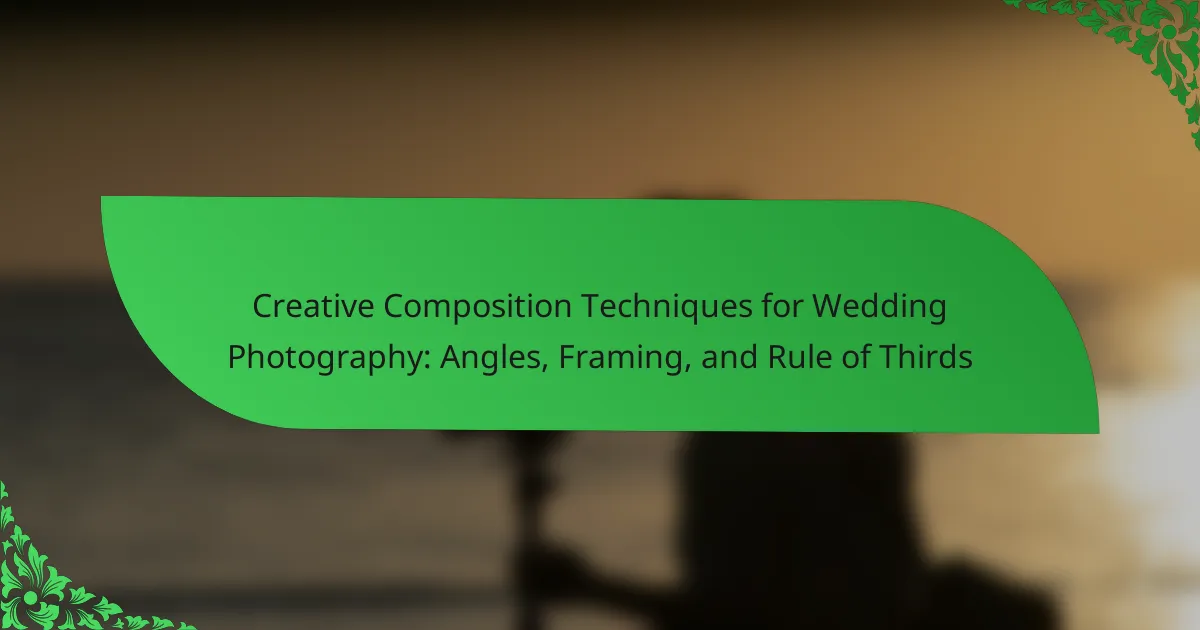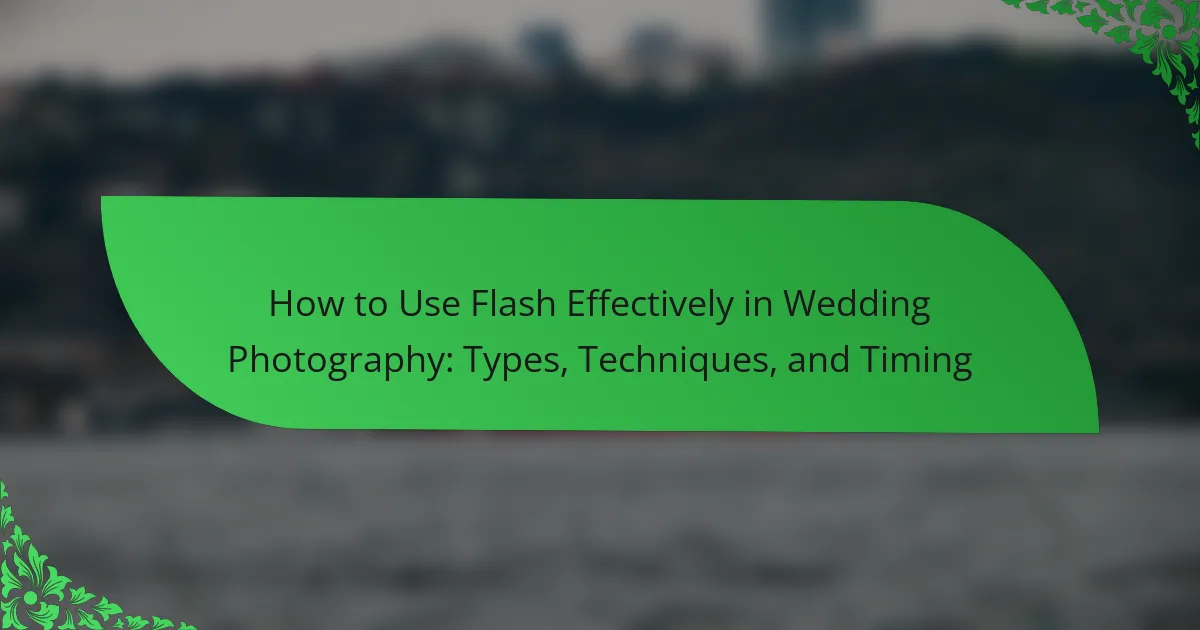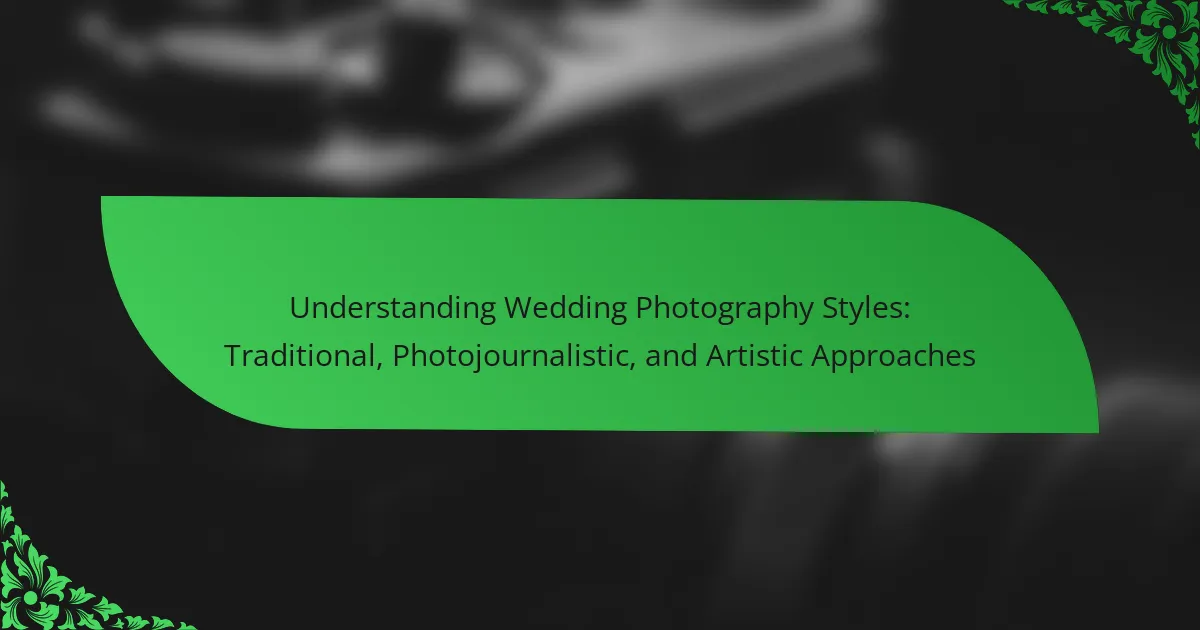The article focuses on the best DSLR cameras for wedding photography, highlighting key models such as the Canon EOS 5D Mark IV, Nikon D850, and Canon EOS R6. It outlines essential features that make these cameras suitable for capturing weddings, including high resolution, fast autofocus, low-light performance, and durability. Additionally, the article discusses the importance of lens compatibility and sensor size in enhancing image quality and performance. Readers will gain insights into selecting the right camera based on these critical factors, ensuring they can effectively document memorable wedding moments.
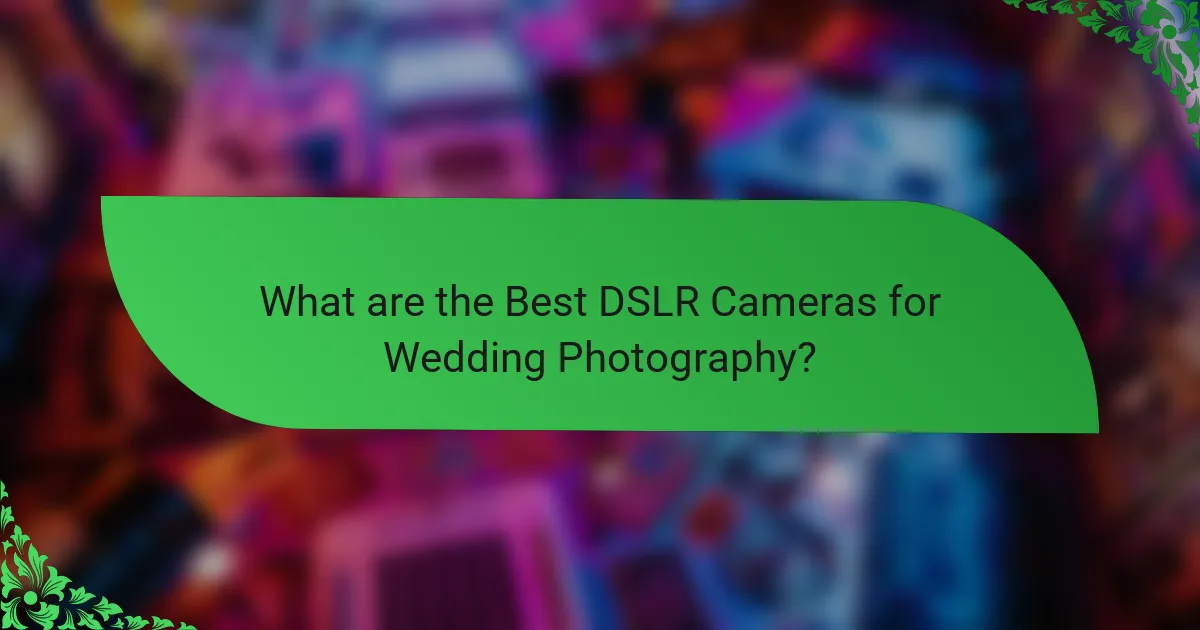
What are the Best DSLR Cameras for Wedding Photography?
The best DSLR cameras for wedding photography include the Canon EOS 5D Mark IV, Nikon D850, and Canon EOS R6. The Canon EOS 5D Mark IV offers a full-frame sensor and exceptional low-light performance. It features a 30.4 MP resolution and a 61-point AF system. The Nikon D850 is known for its 45.7 MP sensor and fast shooting speed of 7 frames per second. It also provides excellent dynamic range and battery life. The Canon EOS R6, while a mirrorless option, has DSLR-like ergonomics. It boasts a 20 MP sensor and superior autofocus capabilities. Each of these cameras is widely recommended by professional photographers for their reliability and image quality in wedding settings.
How do DSLR cameras differ from other camera types for wedding photography?
DSLR cameras differ from other camera types for wedding photography primarily in their image quality and versatility. They typically feature larger sensors compared to point-and-shoot cameras and smartphones. This results in better low-light performance and greater dynamic range. DSLR cameras also offer interchangeable lenses, allowing photographers to choose the best lens for various shooting conditions.
In contrast, compact cameras often have fixed lenses and smaller sensors, limiting their performance in challenging lighting. Mirrorless cameras provide similar image quality but may lack the extensive lens options available for DSLRs. Additionally, DSLRs have faster autofocus systems, which is crucial for capturing fleeting moments during weddings.
The optical viewfinder in DSLRs provides real-time feedback, enhancing composition accuracy. According to a study by the Camera and Imaging Products Association, DSLRs maintain a significant market share due to their reliability and professional-grade features. These attributes make DSLRs particularly suited for the dynamic environment of wedding photography.
What are the key features to look for in a DSLR camera for weddings?
Key features to look for in a DSLR camera for weddings include fast autofocus, high ISO performance, and dual card slots. Fast autofocus ensures sharp images during dynamic moments. High ISO performance allows for better low-light photography, essential for indoor ceremonies. Dual card slots provide backup options for important shots. A weather-sealed body protects against environmental factors. Additionally, a large sensor size enhances image quality and depth of field control. A variety of compatible lenses expands creative options for different shooting scenarios. These features collectively contribute to capturing high-quality wedding photographs.
Why is image quality crucial for wedding photography?
Image quality is crucial for wedding photography because it directly impacts the clarity and emotional resonance of the images. High-quality images capture intricate details, such as [censured] expressions and textures in clothing. These details are essential for preserving memories of a significant event. Additionally, superior image quality allows for better printing and enlargements without loss of detail. According to a study by the Wedding Photojournalist Association, 85% of couples prioritize image quality when selecting a photographer. This emphasis on quality underscores its importance in delivering lasting memories.
What are the top brands of DSLR cameras suitable for weddings?
The top brands of DSLR cameras suitable for weddings are Canon, Nikon, and Sony. Canon offers a range of models known for their excellent autofocus and image quality. Nikon is renowned for its robust build and superior low-light performance. Sony’s DSLR cameras are recognized for their advanced technology and high-resolution sensors. These brands are preferred by professional photographers for wedding shoots. They provide various lens options compatible with wedding photography needs. Canon and Nikon dominate the market, holding significant shares in sales. Sony has gained popularity in recent years for its innovative features.
How do brand reputations impact the choice of DSLR cameras for weddings?
Brand reputations significantly influence the choice of DSLR cameras for weddings. Photographers often prioritize brands known for reliability and image quality. Established brands like Canon and Nikon have built trust through consistent performance in professional settings. Positive brand reputation also affects resale value, making it easier to upgrade equipment later. Many wedding photographers rely on recommendations from peers, reinforcing the impact of brand perception. Studies show that 70% of photographers prefer brands with a strong reputation for customer service. This preference is critical during high-stakes events like weddings, where equipment failure can have serious consequences.
What are the unique offerings of each brand for wedding photographers?
Canon offers wedding photographers a wide range of lenses and superior autofocus systems. Their cameras, like the Canon EOS R5, provide high-resolution images with excellent low-light performance. Nikon provides robust build quality and exceptional color accuracy. The Nikon D850 is known for its impressive dynamic range and high megapixel count. Sony specializes in mirrorless technology, offering lightweight options with advanced video capabilities. The Sony A7 III is popular for its fast autofocus and impressive battery life. Fujifilm is recognized for its unique film simulation modes, appealing to photographers seeking artistic control. The Fujifilm X-T4 delivers excellent image quality and in-body stabilization. Each brand caters to specific needs, enhancing the wedding photography experience through unique features.
What is the price range for DSLR cameras ideal for wedding photography?
The price range for DSLR cameras ideal for wedding photography typically falls between $800 and $3,000. Cameras in this range offer the necessary features for high-quality image capture. Entry-level models start around $800, suitable for beginners. Mid-range options, priced between $1,200 and $2,000, provide better performance and lens compatibility. Professional-grade cameras can exceed $2,500, offering advanced features and superior image quality. This pricing reflects the investment required for reliable performance during weddings, where capturing moments is crucial.
What factors influence the price of DSLR cameras for wedding use?
The price of DSLR cameras for wedding use is influenced by several key factors. Brand reputation significantly affects pricing. Established brands like Canon and Nikon often command higher prices due to their reliability and performance. Camera specifications also play a crucial role. Features such as sensor size, resolution, and autofocus capabilities can increase costs.
The inclusion of advanced technology, like image stabilization and Wi-Fi connectivity, can raise the price further. Build quality is another factor. Cameras designed for durability in various weather conditions typically cost more. The availability of lenses and accessories affects pricing as well. A camera system with a wide range of compatible lenses may be priced higher due to versatility.
Market demand impacts prices too. High demand for specific models during wedding seasons can lead to increased prices. Lastly, the age of the model matters. Newer models with updated features tend to be more expensive than older versions.
How can photographers find budget-friendly DSLR options without compromising quality?
Photographers can find budget-friendly DSLR options by researching reputable brands known for quality. Brands like Canon, Nikon, and Sony often offer entry-level models that maintain good performance. Reading user reviews and professional evaluations helps gauge quality. Comparing specifications such as sensor size, autofocus system, and ISO performance is crucial. Websites like DPReview and Consumer Reports provide in-depth comparisons and ratings. Additionally, purchasing refurbished or older models can yield significant savings without sacrificing essential features. Many photographers have successfully transitioned to budget models while still achieving professional results.

What are the Essential Features of DSLR Cameras for Wedding Photography?
Essential features of DSLR cameras for wedding photography include high resolution, fast autofocus, and low-light performance. High resolution, typically 20 MP or more, ensures detailed images. Fast autofocus is crucial for capturing fleeting moments. Low-light performance allows for quality shots in dim settings, common during receptions. Additionally, a good burst mode enables rapid shooting, capturing multiple frames in quick succession. Weather sealing is important for outdoor weddings, protecting the camera from elements. Lastly, lens compatibility is vital, offering a range of options for different shooting scenarios. These features collectively enhance the photographer’s ability to capture memorable wedding moments effectively.
Why is autofocus performance important in wedding photography?
Autofocus performance is crucial in wedding photography because it ensures sharp images of fleeting moments. Weddings are dynamic events with fast-moving subjects. Effective autofocus systems can quickly lock onto subjects, preventing missed shots. Studies show that professional wedding photographers often prioritize cameras with advanced autofocus capabilities. For instance, cameras with multiple autofocus points can track subjects more accurately. This is essential for capturing key moments like vows or first dances. A camera with reliable autofocus can significantly enhance the overall quality of wedding photos. Thus, autofocus performance directly impacts the success of wedding photography.
What types of autofocus systems are most effective for capturing weddings?
Phase Detection and Contrast Detection autofocus systems are the most effective for capturing weddings. Phase Detection offers quick focusing, essential for fast-paced wedding environments. It works by measuring the phase difference of light rays entering the camera. This system is typically found in DSLRs and some mirrorless cameras. Contrast Detection, while slower, provides high accuracy in still scenes. It analyzes the contrast in the image to achieve focus. Many modern cameras combine both systems for optimal performance. This hybrid approach enhances focus speed and accuracy, vital for capturing fleeting moments during weddings.
How does low-light performance affect wedding photography?
Low-light performance significantly impacts wedding photography by determining the quality of images captured in dimly lit environments. High low-light performance allows photographers to use faster shutter speeds, reducing motion blur. It also enables the use of wider apertures, which lets in more light and creates a shallower depth of field. This capability is crucial during evening receptions or indoor ceremonies where lighting is often limited. Cameras with better low-light performance produce clearer images with less noise. According to a study by DxOMark, sensors with higher ISO capabilities can enhance image quality in low-light conditions, making them ideal for wedding photography.
What lens compatibility should photographers consider for wedding DSLR cameras?
Photographers should consider lens compatibility based on the camera brand and mount type. Each DSLR camera brand, such as Canon, Nikon, or Sony, has specific lens mounts. Compatible lenses must match these mounts to function correctly.
For wedding photography, versatile lenses are essential. A fast prime lens, like a 50mm f/1.8, is ideal for low-light situations. Zoom lenses, such as a 24-70mm f/2.8, provide flexibility for various shooting scenarios.
Additionally, photographers should verify autofocus compatibility. Some older lenses may not support advanced autofocus features in newer camera bodies. Checking for image stabilization is also crucial, especially for handheld shooting.
Using third-party lenses can expand options. Brands like Sigma and Tamron offer compatible lenses that may be more affordable. Always confirm compatibility through manufacturer specifications before purchase.
What types of lenses are best for different wedding scenarios?
Prime lenses are best for capturing portraits during weddings. They typically have a wide aperture, allowing for excellent low-light performance. A 50mm f/1.8 lens is ideal for close-up shots of the couple. A 85mm f/1.4 lens provides beautiful bokeh for wedding portraits. Zoom lenses are versatile for various wedding scenarios. A 24-70mm f/2.8 lens is great for ceremony and reception coverage. A 70-200mm f/2.8 lens is perfect for candid shots from a distance. Wide-angle lenses are essential for group photos and venue shots. A 16-35mm f/4 lens captures expansive scenes effectively.
How does lens choice impact the final wedding photos?
Lens choice significantly impacts the final wedding photos by influencing composition, depth of field, and light capture. Different lenses have unique focal lengths that affect how subjects are framed. For instance, wide-angle lenses capture expansive scenes, ideal for group shots. Conversely, telephoto lenses allow for close-up portraits from a distance, creating a more intimate feel.
The aperture size of a lens affects depth of field. A lens with a wide aperture blurs the background, emphasizing the subject. This technique is often used in portraits to create a dreamy effect. In contrast, a lens with a narrow aperture keeps more elements in focus, which is useful for capturing details in venue shots.
Light capture varies by lens type as well. Lenses with larger front elements can gather more light, making them suitable for low-light conditions, common during evening receptions. This capability ensures that images remain sharp and well-exposed.
Ultimately, the choice of lens directly affects the aesthetic and technical quality of wedding photos. Photographers must select lenses that align with their creative vision and the specific moments they wish to capture.
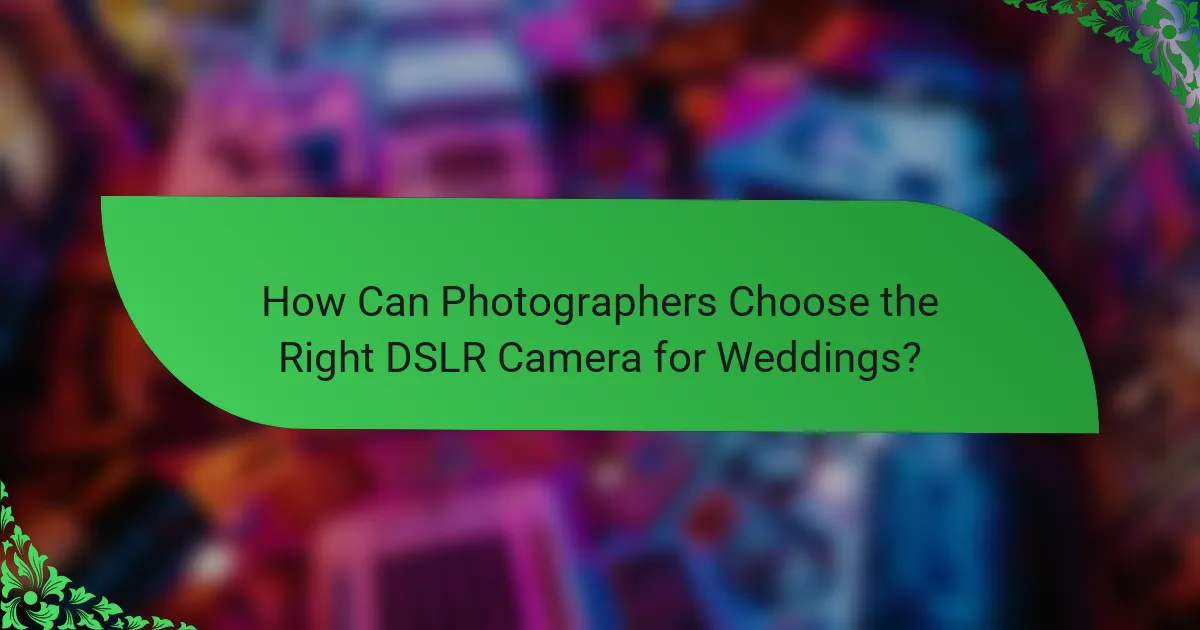
How Can Photographers Choose the Right DSLR Camera for Weddings?
Photographers can choose the right DSLR camera for weddings by considering key features that enhance image quality and performance. Important factors include sensor size, autofocus capabilities, and low-light performance. A full-frame sensor typically delivers better image quality, especially in dim lighting. Fast and accurate autofocus is crucial for capturing fleeting moments during ceremonies. Additionally, cameras with high ISO performance allow for clearer images in low-light situations, such as receptions. Durability and weather sealing are also vital, as weddings often take place in varied environments. Lastly, lens compatibility is essential; photographers should ensure their camera can accommodate a range of lenses for different shooting scenarios.
What are the top tips for selecting a DSLR camera for wedding photography?
Consider the camera’s sensor size when selecting a DSLR for wedding photography. A full-frame sensor provides better low-light performance and depth of field control. Look for a camera with fast autofocus capabilities. Quick and accurate autofocus is essential for capturing fleeting moments. Evaluate the camera’s ISO range. A higher ISO range allows for better performance in dim lighting conditions, which is common at weddings. Check for dual card slots. This feature offers backup options for important photos. Assess the availability of compatible lenses. A variety of lenses enhances versatility for different shooting scenarios. Finally, consider ergonomics and weight. A comfortable, lightweight camera is easier to handle during long events.
How can photographers assess their specific needs for wedding shoots?
Photographers can assess their specific needs for wedding shoots by evaluating their equipment, style, and client expectations. They should begin by identifying the types of shots they want to capture, such as candid moments or posed portraits. Next, they need to consider the lighting conditions of the venue, which can influence camera settings and lens choices. Photographers should also evaluate their experience level with different camera settings and techniques. Additionally, understanding the couple’s preferences regarding photography style is crucial. This assessment process helps photographers select the appropriate DSLR camera, lenses, and accessories needed for the shoot. Conducting a pre-wedding consultation can further clarify expectations and requirements.
What common mistakes should photographers avoid when choosing a DSLR?
Photographers should avoid several common mistakes when choosing a DSLR. One mistake is not considering the camera’s sensor size. A larger sensor typically provides better image quality and low-light performance. Another mistake is overlooking lens compatibility. Different brands have varying lens options, which can affect versatility. Photographers often ignore the importance of ergonomics. A comfortable grip can enhance shooting experience during long events. Failing to check autofocus capabilities is also common. Fast and accurate autofocus is crucial for capturing fleeting moments. Additionally, photographers may neglect the importance of battery life. Longer battery life is essential for extended shoots like weddings. Lastly, not researching the available features can lead to dissatisfaction. Understanding features like video capability and connectivity is vital for modern photography needs.
What practical advice can enhance the use of DSLR cameras in wedding photography?
To enhance the use of DSLR cameras in wedding photography, focus on mastering manual settings. Adjusting exposure, aperture, and ISO allows for better control over lighting conditions. Utilize fast lenses for low-light situations, ensuring sharp images during evening receptions. Employ continuous shooting mode to capture fleeting moments, increasing the chances of getting the perfect shot. Use a tripod or monopod for stability, especially during long ceremonies. Familiarize yourself with the camera’s autofocus system to ensure quick and accurate focusing on subjects. Practice composition techniques, such as the rule of thirds, to create visually appealing images. Lastly, ensure you have backup batteries and memory cards to avoid interruptions during the event. These practices are supported by professional photographers who emphasize preparation and adaptability in dynamic environments like weddings.
How can photographers effectively prepare their DSLR for a wedding shoot?
Photographers can effectively prepare their DSLR for a wedding shoot by following a systematic checklist. First, they should clean the camera sensor and lenses to ensure clear images. Next, photographers must check battery levels and bring extra batteries to avoid interruptions. They should also format memory cards and ensure sufficient storage space for the day. Setting the camera to the appropriate shooting mode for low-light conditions is essential, as weddings often take place indoors or during evening hours. Additionally, photographers should test their gear, including lenses and flashes, to confirm everything is functioning properly. Finally, creating a backup plan with extra equipment can safeguard against unexpected issues. Proper preparation enhances the likelihood of capturing stunning wedding photos.
What are the best practices for maintaining a DSLR camera during weddings?
To maintain a DSLR camera during weddings, ensure regular cleaning and proper handling. Use a microfiber cloth to clean the lens and body. Protect the camera from moisture and dust by using weather-sealed equipment. Keep spare batteries and memory cards accessible to avoid interruptions. Adjust camera settings before the event to suit the lighting conditions. Monitor the camera for overheating during extended use. Use a tripod for stability, especially in low-light situations. Regularly check focus and exposure throughout the event. These practices help ensure optimal performance and image quality during wedding photography.
The primary entity of this article is DSLR cameras specifically tailored for wedding photography. It provides a detailed overview of the best DSLR options, including models from Canon and Nikon, highlighting their key features such as image quality, autofocus performance, and low-light capabilities. The article also discusses the differences between DSLR and other camera types, essential features for wedding photography, and price ranges, alongside guidance on lens compatibility and brand reputations. Additionally, it offers practical tips for photographers on selecting the right camera and maintaining equipment during wedding events.
